Here we go again: A beginner’s guide to Israel’s 2nd election in 2019
Published September 9, 2019
(JTA) — Trying to understand next week’s Israeli elections can get confusing. Especially since we’re talking about the second election in one year.
Longtime Prime Minister Benjamin Netanyahu is mired in a series of corruption scandals and again facing a serious challenge from former military chief of staff Benny Gantz. Neither of them looks assured of victory, and they may be stuck with each other in what’s called a unity government, where the two leading parties try to run the country together “Odd Couple”-style.
The Sept. 17 vote comes just five months after the last one ended with no clear winner and Netanyahu unable to form a governing coalition.
Israeli politics are famously tumultuous, but this is unprecedented: This is the first time Israel has had two elections in such a short period of time.
The following guide, which is broken into topical-based sections, breaks down how Israel’s government is constructed, why Israelis are going to the polls again and who the major players are in the campaign to govern the Jewish state. Click on the links below as a shortcut, or scroll through for a complete primer.
Index
Israel’s nine biggest political parties, each explained in one sentence
Why is there a second Israeli election in 2019?
A Knesset poll tracker from the Israel Policy Forum
Can Netanyahu withstand his big corruption scandals?
The rise of Benny Gantz’s coalition, a formidable challenger to Netanyahu
Netanyahu and his rivals may be forced to govern together
The steep fall of the Labor Party
Israeli Arabs aim to regain their political power
The rise of fake news in Israel
Israel’s nine biggest political parties, each explained in one sentence
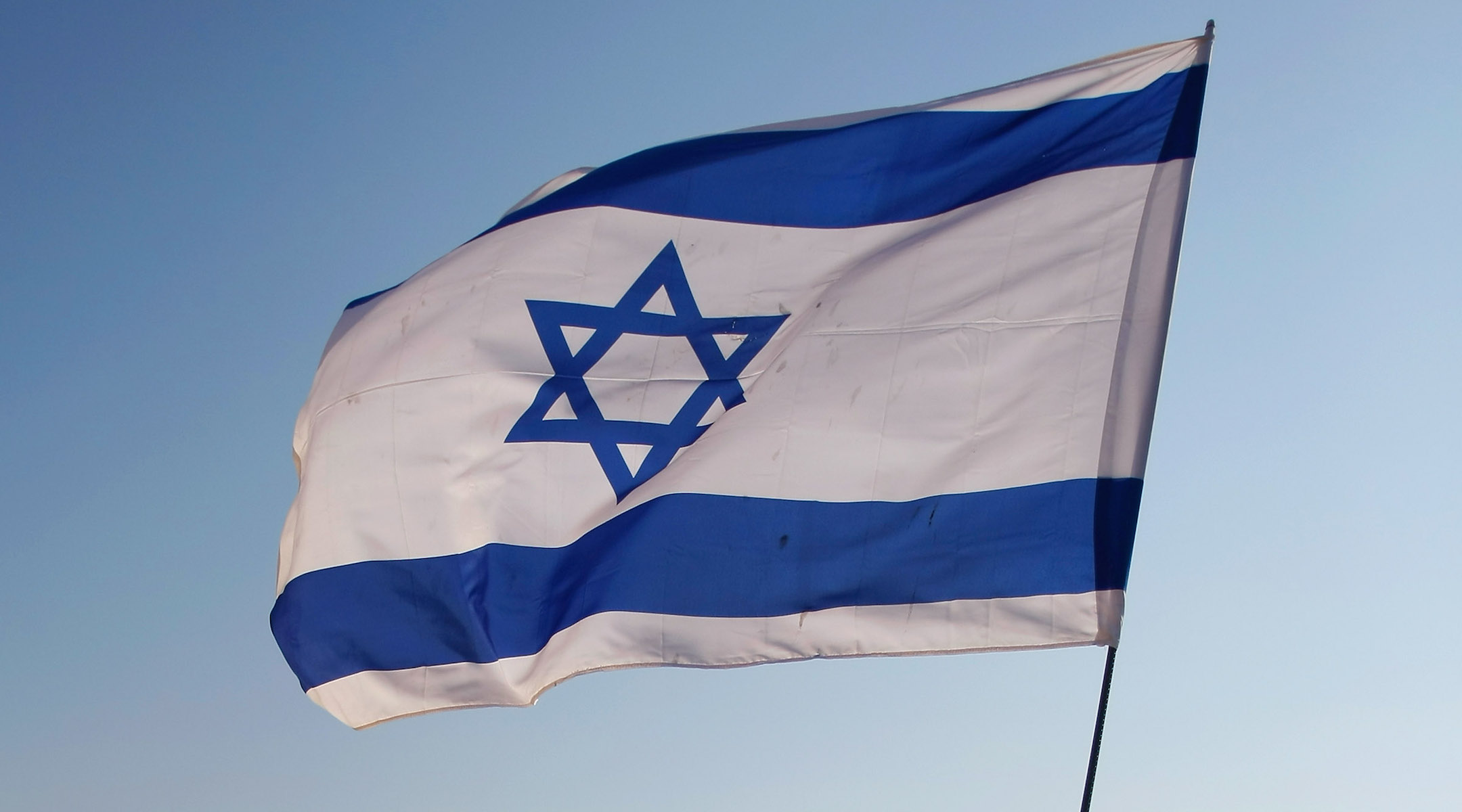
(David Silverman/Getty Images)
Israel’s election is a free for all: Instead of two major parties, there are 31 parties competing at the ballot box. Israelis vote for parties, not individual candidates (the candidates are chosen by the parties, some through primaries). The more votes a party gets, the more seats it has in Israel’s 120-seat parliament, the Knesset. A government is formed by a coalition of (mostly) like-minded parties that captures a majority of more than 60 seats.
Nine parties are slated to make the next Knesset, though there are usually surprises. Here’s a short description of each of them.
The front-runners:
Likud, Israel’s right-wing flagship and Netanyahu’s party, opposes a Palestinian state, supports settlements and encourages privatization in the economy. Its main selling point, however, is the long-serving prime minister, who is seeking his fifth term.
Blue and White is a centrist coalition led by Gantz, a one-time army general. It was created to oppose Netanyahu and his alleged corruption.
Supporting actors on the right:
Yamina is an alliance between the hard right and religious Zionists that supports increasing Orthodoxy’s influence in Israel and settlement growth while staunchly opposing Palestinian statehood.
Yisrael Beiteinu champions the interests of Russian-speaking immigrants and is focusing its campaign on lessening the influence of Orthodox parties in government.
United Torah Judaism is the Ashkenazi haredi Orthodox party — the guys (they’re all guys) who support Orthodox control of Israel’s religious life, oppose mandatory army service for their followers and speak Yiddish.
Shas is the Sephardi haredi party — the guys (again, all guys) who stand for religious traditionalism as well as the rights of Israel’s Mizrahi (Middle Eastern and North African) Jewish population.
Supporting actors on the left:
Labor is the sad trombone of Israeli politics: Once the left-wing flagship and largest party in the country, it’s now an also-ran that has joined with a centrist party called Gesher in a bid for more votes.
The Democratic Union is a fusion of a couple of factions, including one led by former Prime Minister Ehud Barak, that is is about as far left as you can go while remaining Zionist. Democratic Union backs a Palestinian state alongside Israel along with minority rights and religious pluralism within Israel.
The Joint List is a union of four disparate Arab-Israeli parties that advocates for that minority’s rights in Israel, as well as Palestinian statehood.
— Ben Sales
Why is there a second election in 2019?
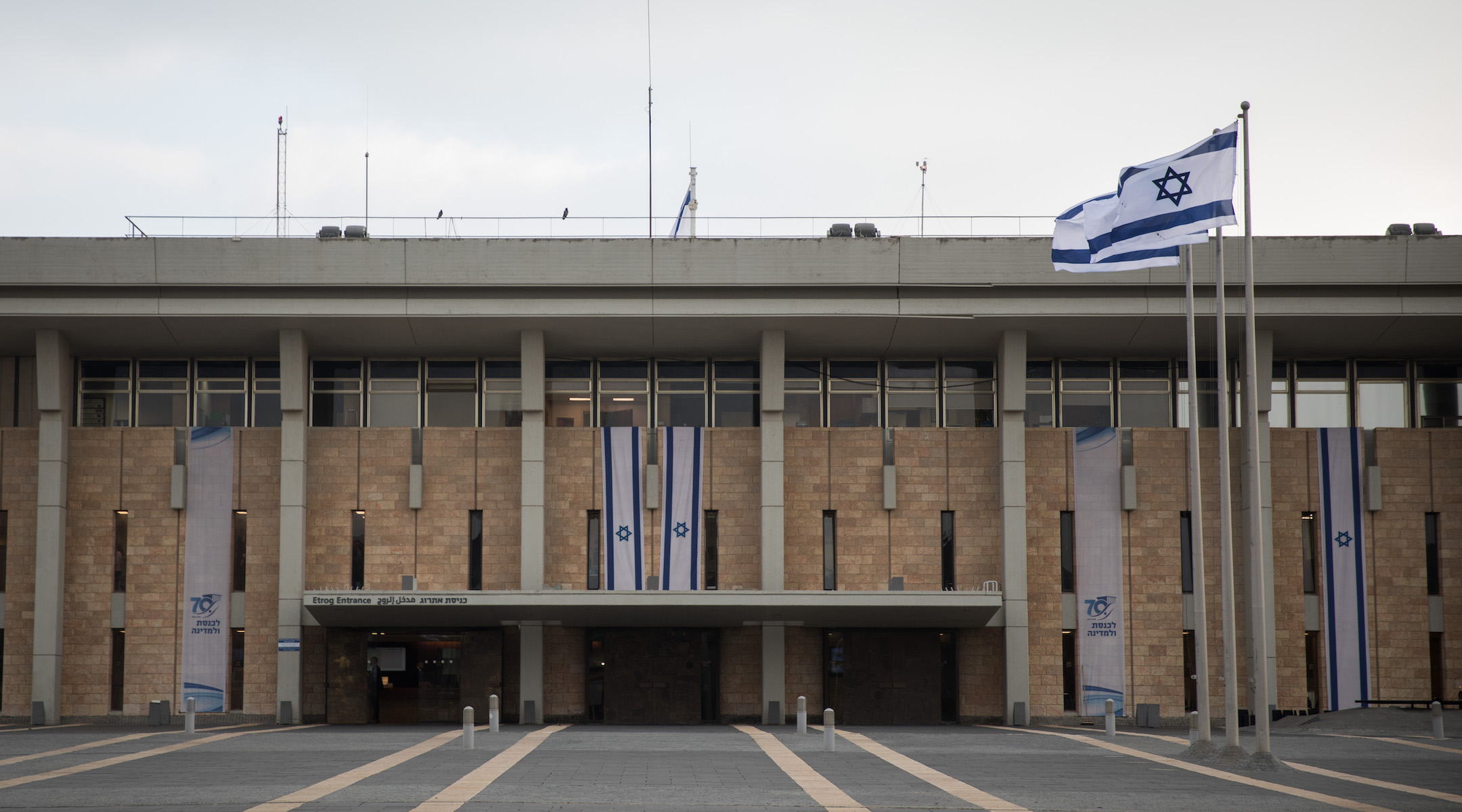
A view of the main building of the Knesset, Israel’s parliament, in Jerusalem, Dec. 26, 2018. (Hadas Parush/Flash90)
First, it’s important to understand how Israel’s government works.
In broad strokes, the government operates under a proportional representation system, and elections are held every four years (unless they are called earlier, which they almost always are. See below for more on why).
There are 120 seats in the Knesset. To gain a seat, a party needs to win at least 3.25 percent of the vote. Whoever wins at least 61 seats controls the government.
Simple enough, right?
Well, no — because no party has ever won the necessary 61 seats. That means the party with the most votes has to form coalitions with other smaller parties to reach the threshold.
In the 2015 elections, the Netanyahu-led Likud won 30 seats and formed a coalition with smaller right-wing and religious parties. But it began to fold in 2019 when the right-wing, secularist Yisrael Beiteinu left the coalition, disgusted by a cease-fire with Gaza militants. Sure enough, coalition disagreements over a bill to draft haredi Orthodox men into the military caused the party heads to call for new elections. The parties were also tense over Netanyahu’s pending indictment for corruption.
But a funny thing happened in the April elections. The right wing seemed like it won a majority again, but Netanyahu couldn’t form another coalition. The issue was the same one that doomed his last government: the haredi, or ultra-Orthodox, draft bill. Yisrael Beiteinu insisted that it be passed, and the haredi parties insisted that it be softened. Unable to pull his partners together, and scared of giving his rivals a chance to form a government, Netanyahu called for another round of elections.
— Emily Burack
A Knesset poll tracker from the Israel Policy Forum
Polling data displayed by the Israel Policy Forum shows Likud and Blue and White virtually tied at the top as smaller parties compete for their own shares of the vote. No party can form a majority ruling coalition without partnering with smaller parties. For updates, see IPF’s site.
Can Netanyahu withstand his big corruption scandals?
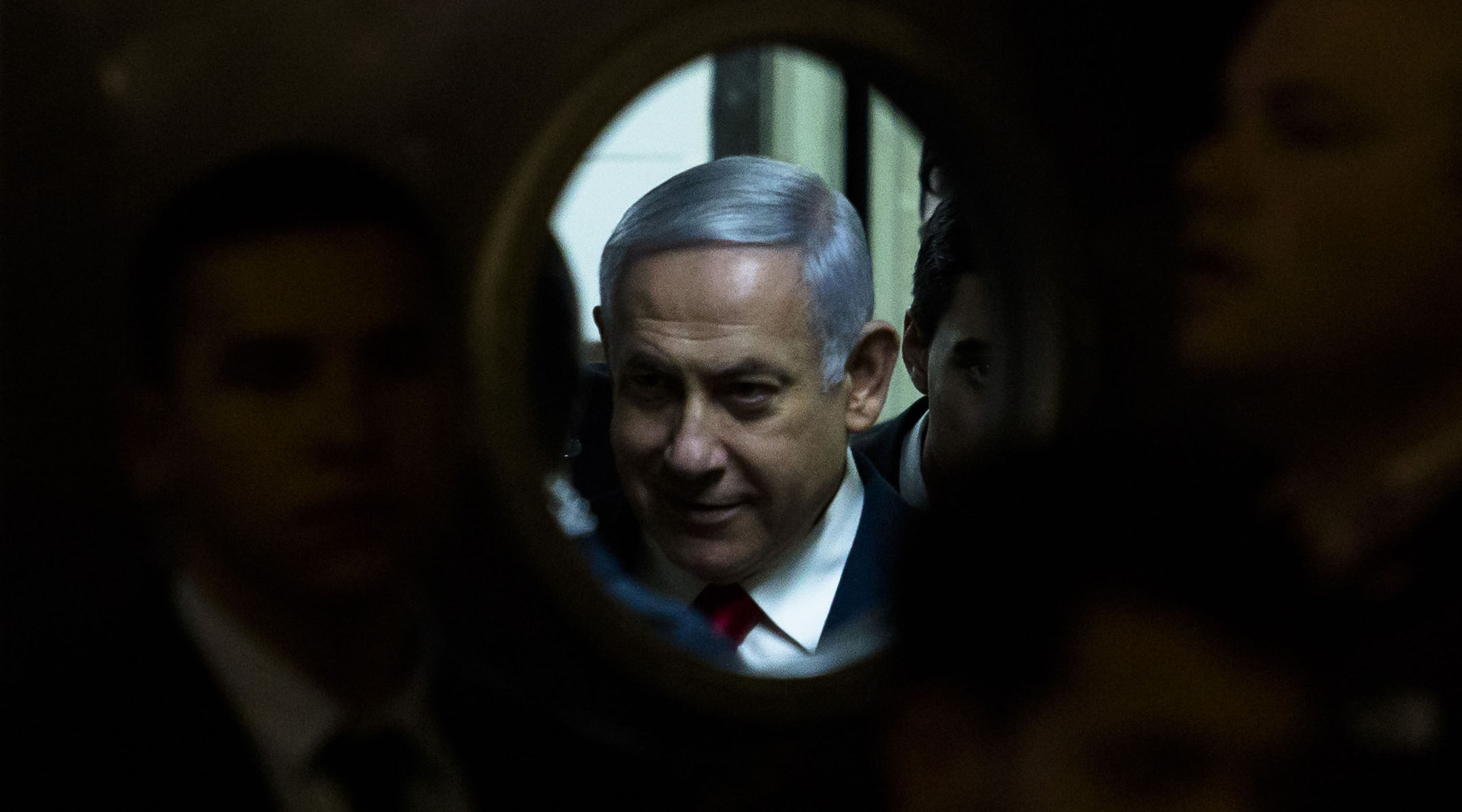
Prime Minster Benjamin Netanyahu attends the launch of the Likud party election campaign in Ramat Gan, March 4, 2019. (Amir Levy/Getty Images)
Benjamin Netanyahu is the first sitting prime minister to be indicted on criminal charges – but that doesn’t mean he won’t be re-elected.
Netanyahu allegedly attempted to improve his media coverage through illegal dealmaking on multiple occasions and is accused of receiving $200,000 in illegal bribes of Cuban cigars and champagne.
On Feb. 28, Attorney General Avichai Mandelblit made the decision to indict Netanyahu in three separate corruption cases. But under Israeli law, a hearing must precede the formal filing of charges. This hearing won’t be held until October, after the elections.
Netanyahu’s situation is not quite unprecedented: In 2008, his predecessor, Ehud Olmert, resigned before he was formally indicted on bribery charges. Olmert eventually was convicted and served 16 months in prison of a 27-month sentence.
But unlike Olmert, Netanyahu will not step down and remains defiant.
“[The left has] mounted a thuggish, incessant campaign of pressure – I’d say almost inhuman – on the attorney general,” Netanyahu said the day the indictment was issued.
Netanyahu served a term as prime minister in the 1990s and has served continuously for the past decade. He remains relatively popular among a plurality of voters — or at least more tolerable than his rivals. Some polls have shown Blue and White surpassing him, but if current polling holds, it’s unclear whether either side will be able to form a government.
The Netanyahu base has remained loyal throughout the scandals. They see him as an effective captain of Israel’s ship in a turbulent region. His current administration has spanned the Great Recession, the Arab Spring, the Syrian Civil War and two conflicts with Hamas in Gaza — not to mention two American presidents. Through it all, his supporters say, he has kept Israel stable, thriving economically and as safe as possible.
Of late, Netanyahu has also trumpeted his relationships with leaders across the world, from Vladimir Putin to Xi Jinping — and especially Donald Trump. He says he’s the only leader who can be trusted to safeguard Israel’s interests. This year, one of his slogans is “Netanyahu: Another League,” and giant banners on his Tel Aviv campaign headquarters show him shaking hands with Trump and Putin. The chorus of his campaign jingle begins “Yalla Putin, yalla Trump, come to us in Jerusalem.”
Even if Netanyahu is re-elected and formally indicted, there is likely no legal requirement that he step down from office — though not leaving would certainly be an eyebrow-raising choice.
– Laura E. Adkins
The rise of Benny Gantz’s coalition, a formidable challenger to Netanyahu
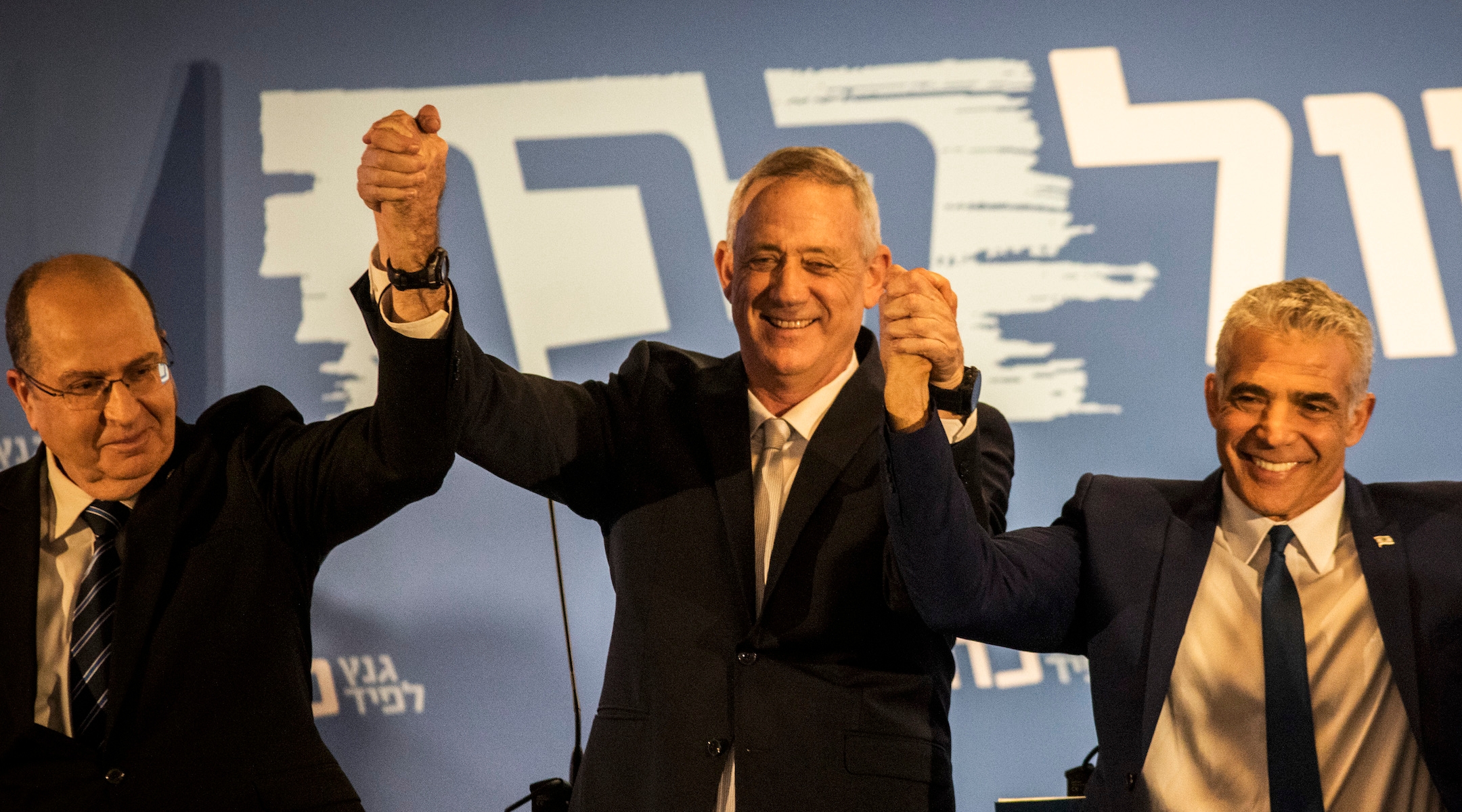
From left to right: Moshe Yaalon, Benny Gantz and Yair Lapid, the leaders of the Blue and White coalition, at the announcement of their alliance in Tel Aviv, Feb. 21, 2019. (Ilia Yefimovich/Getty Images)
After dispatching a series of opponents over the past decade, Netanyahu appears to have met a worthy adversary.
In February, Gantz decided to merge his new party with Yesh Atid, a centrist party headed by former news anchor Yair Lapid and focused primarily on economic and social issues. They named the alliance Blue and White for the colors of Israel’s flag.
In the April election, Blue and White fought Netanyahu’s Likud to a tie, each winning 35 seats in the 120-seat Knesset.
After nearly two complete election campaigns, it’s still hard to discern where exactly Gantz stands on most issues. But from what we’ve seen, he is a centrist. Blue and White’s platform emphasizes global collaboration on security issues and true Israeli democracy that recognizes Arab Israelis as equal citizens and requires religious Jews to serve in the army.
Though this is Gantz’s first (or second) foray onto the political stage, he is well respected as a general, having served as the army’s chief of staff from 2011 to 2015. In Israel, former chiefs of staff cannot serve in Knesset for at least three years after completing their service, so this year was Gantz’s first opportunity to run.
Ahead of the September election, Likud and Blue and White are virtually tied in the polls, with both expected to again pick up somewhere in the neighborhood of 30 seats. The party that receives the most seats will have another chance to cobble together a governing majority coalition of at least 61 seats. But with neither appearing able to garner a majority, they may have to govern together after seven months of campaigning against each other.
– Laura E. Adkins
Netanyahu and his rivals may be forced to govern together
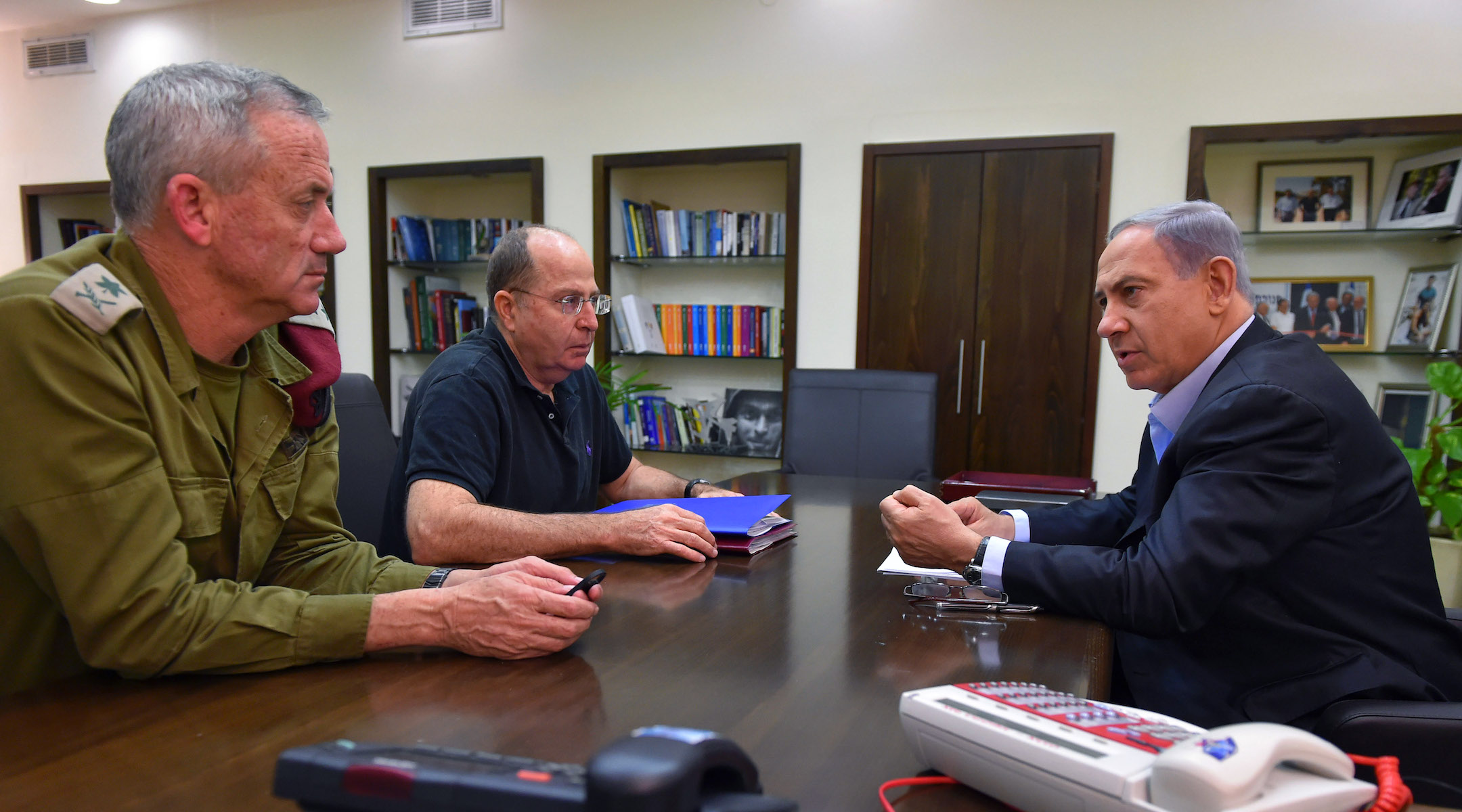
Prime Minister Benjamin Netanyahu confers with Defense Minister Moshe Yaalon, left, and Gen. Benny Gantz during the 2014 Gaza War. Gantz and Yaalon are now running against Netanyahu in the Israeli election, but they may all be forced to share power once it’s over. (Ariel Harmoni/Getty Images)
In the weeks leading up to the election, Netanyahu has repeatedly accused Gantz of attempting to steal the election. Gantz in turn has accused Netanyahu of delegitimizing Israeli democracy.
Plot twist! After the election, they may have to go from demonizing each other to working together.
Their parties will almost certainly take the top two spots, but neither Netanyahu nor Gantz seems likely to assemble a 61-seat coalition of allies. That’s what happened after the previous election, in April, which is why there’s a second election five months later.
If neither candidate can cobble together a majority on their own, the only remaining option (besides a truly bonkers third election) is what’s called a unity government, where the two biggest parties form a large compromise coalition and govern together — perhaps even rotating the job of prime minister between them.
That sounds unworkable, but it’s actually happened a few times in Israel’s past — with mixed results. Here’s a brief history of unity governments in Israel:
* In 1967, just ahead of the pivotal Six-Day War, Prime Minister Levi Eshkol aimed to demonstrate a united front by inviting opposition parties into his government (what’s called a “war cabinet” in the United Kingdom). That unity government ended after Eshkol died in office in 1969.
* In 1984, neither of the two largest parties — Likud and the Alignment, a predecessor to the Labor Party — were able to form a government alone. So they governed together (functionally!) for a complete four-year term. For the first time, the two party leaders rotated the premiership, with each taking two years.
* In 1988, the two parties again formed a unity government, but Likud had outperformed the Alignment in the election, so Likud leader Yitzhak Shamir served a full term as prime minister. That government ended in 1990, when Alignment leader Shimon Peres tried (and failed) to topple the government in what’s now known as the “Dirty Trick.”
* In 2012, a short-lived unity government had the centrist party Kadima joining Netanyahu’s right-wing coalition. The unity government broke up two months later — over the issue of drafting haredi men into the military. Sound familiar?
This time around, Netanyahu and Gantz both say they don’t want a unity government. Gantz’s party was basically created to oppose Netanyahu, so partnering with him would be a tough sell. Gantz has said he would partner with Likud if Netanyahu steps down, which appears pretty unlikely.
— Ben Sales
The steep fall of the Labor Party
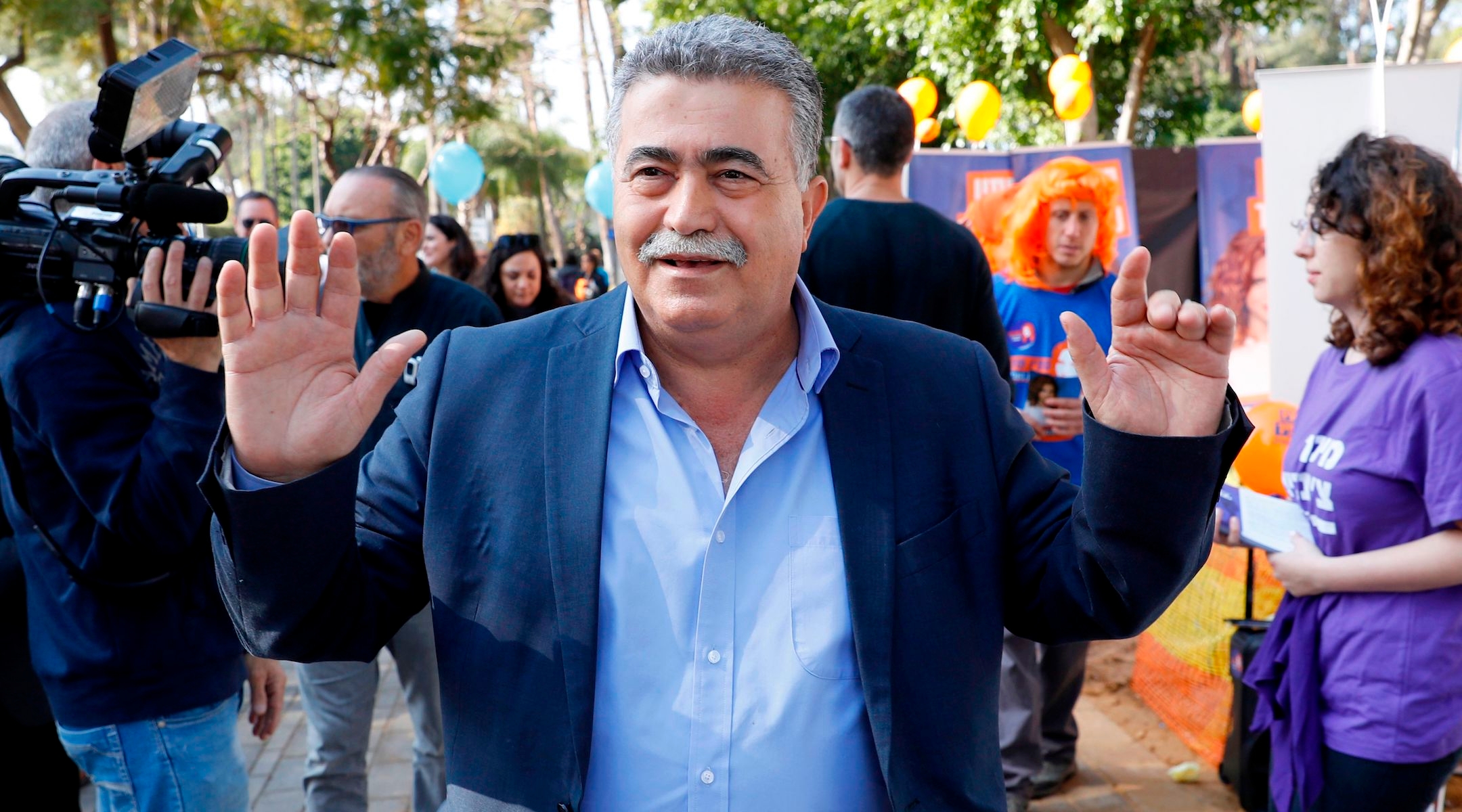
Amir Peretz, a former defense minister, poses during the Labor Party primaries in Tel Aviv, Feb. 11, 2019. (Jack Guez/Getty Images)
The party that founded the State of Israel and governed it for three straight decades is now, to put it bluntly, weak sauce.
The party of many Israeli political legends — think David Ben-Gurion, Golda Meir and Yitzhak Rabin — is now barely expected to make it into the Knesset. It hasn’t won an election in two decades and has been supplanted as the main opposition party by Blue and White. Its best hope is to be a very junior coalition partner in the next government.
What happened? Labor used to be almost synonymous with Israel: It stood for social democracy, kibbutzim, a strong defense posture and negotiations with the Palestinians. In 1999, it was riding high: Party leader Ehud Barak had defeated Netanyahu in the election and was pushing toward a peace treaty with the Palestinians. But negotiations failed and the second intifada began — an unprecedented wave of terror attacks that led to a clampdown on Palestinians in the West Bank.
Since then, Labor has lost its mojo. Likud and its offshoots have led the Israeli government for the past 18 years. Israelis have lost hope in peace coming anytime soon (even though a large portion still supports Palestinian statehood). And the whole country, including Labor itself, has moved away from Israel’s former socialist identity. More of the country has become privatized, and though inequality remains high and housing prices have risen steadily, the overall economy is humming along.
Labor has tried to rebrand as a centrist party and came close to winning the election in 2015. But it garnered a record-low six seats in the April elections as voters gravitated to Blue and White. Since then, Labor members elected former leader Amir Peretz to again head the party. Peretz had a decent showing last time he was in charge, winning 19 seats in 2006. He served then as defense minister, but stepped down following the 2006 Lebanon War, which was viewed as a failure.
This time, Peretz has tacked to the center and joined up with an economically focused centrist party. Its poll numbers are again looking bad, as centrist voters appear to again be opting for Blue and White. Ehud Barak, the last Labor leader to win an election, has moved to another left-wing party, the Democratic Union, which is outpolling Labor.
Not too long ago, the choice in Israel was between Likud on the right and Labor on the left. Now Labor is hardly even part of the conversation.
— Ben Sales
Israeli Arabs hope to regain their political power
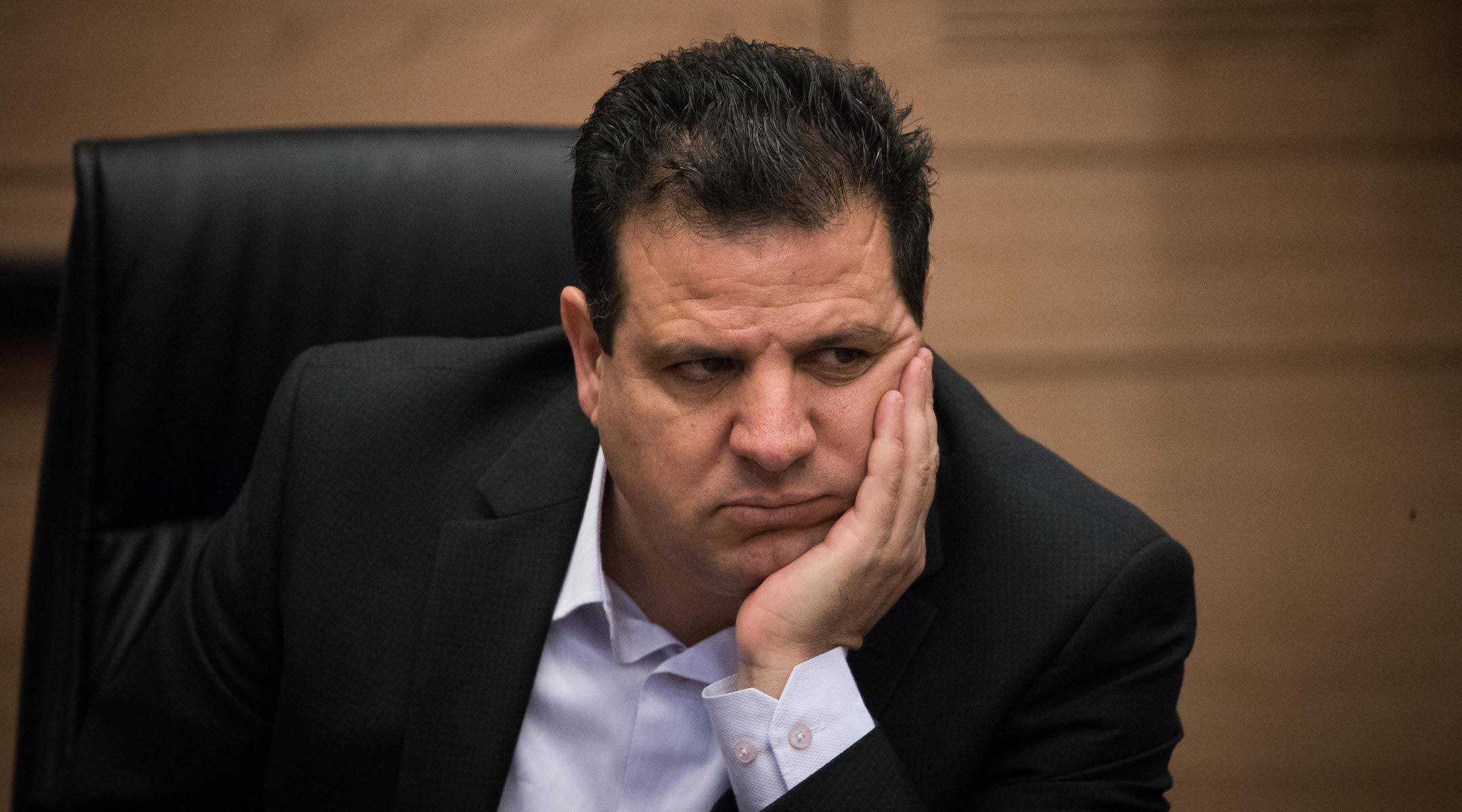
Ayman Odeh, the leader of the Hadash party, attends a Knesset session in Jerusalem, Jan. 1, 2019. (Yonatan Sindel/Flash90)
Israel’s Arab minority has the right to vote, but those votes usually don’t mean much. Arab-Israeli parties never sit in Israeli governing coalitions and are usually at odds with both the Israeli Jewish left and right. But this time, Arab Israelis are hoping to make a strong showing at the ballot box — and in Israel’s halls of power.
For the elections in 2015, the four Arab-Israeli parties united in a coalition called the Joint List and became Israel’s third largest party, as well as a symbol of opposition to the right-wing government. Netanyahu’s fears of Arab political power culminated in an infamous Election Day video warning of “Arabs streaming in droves to the ballot box” (where, as citizens, they have the right to vote).
Despite its size during the last term, the Joint List could not block legislation that it hated, including the Nation-State Law, which defined Israel as a Jewish state and reserved the right of national self-determination in Israel to Jews.
Ahead of the April elections, it split, with the four parties running as two competing factions. The schism was the result of political infighting and led to a collective loss of representation, from 13 total seats to just 10.
Now the Joint List is back and hoping to regain its 2015 numbers. But it’s unclear if that will happen. Right now, it’s polling around 10 or 11 seats.
Netanyahu’s Likud is also paying attention to the Arab vote. During the April election, Likud sent private citizen observers with hidden cameras to film Arab polling places. Likud said the cameras were meant to ensure election security, but critics said they were aimed at intimidating voters and depressing the Arab turnout.
For this vote, the Central Elections Committee banned cameras in polling stations, prompting Netanyahu to accuse his opponents of trying to “steal the election.” A Likud-sponsored bill to allow the cameras has stalled.
It may not make much difference anyway. Parties across the political spectrum have long refused to join coalitions with Arab-Israeli political parties. Politicians usually frame this refusal around the Arab-Israeli parties’ opposition to Zionism and Israel’s Jewish character, which are fundamental to the platforms of the major Jewish parties. Arab-Israeli parties have never been part of an Israeli government.
Ayman Odeh, the leader of the Joint List and currently of Hadash, wrote in a New York Times op-ed in March that the time has come for Israel’s left to include Arab-Israeli parties in the coalition.
“If the center-left parties believe Palestinian citizens of Israel have a place in this country, they must accept that we have a place in its politics,” he wrote. “We cannot build a shared future if we are relegated to the back seats of the Knesset chamber.”
But it’s almost certain that that plea will go unheard. Netanyahu’s main opponents, Blue and White, are centrists who, if anything, lean to the right. And they have already vowed not to partner with Arab-Israeli parties.
— Ben Sales
The rise of fake news in Israel
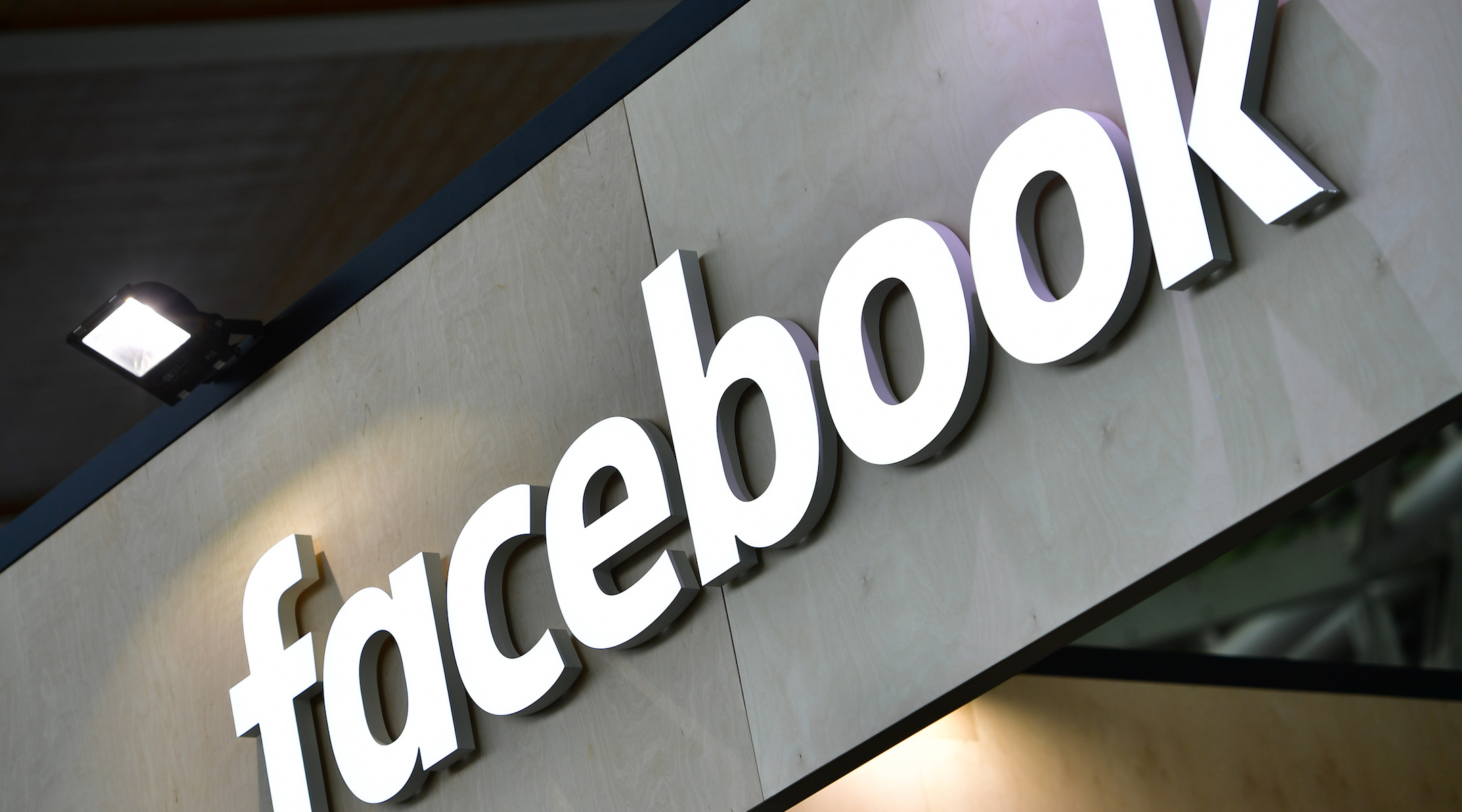
(Alexander Koerner/Getty Images)
It was only a matter of time: The “fake news” epidemic has reached Israel.
For example, after Avigdor Liberman resigned as defense minister in November, a Twitter account later deemed to be dubious began sending Israeli journalists links to news stories accusing him of being a Russian spy. They were fake.
Israel’s Foreign Ministry was aware of the possibility of the spread of fake news even earlier than Liberman’s resignation. In November, it warned journalists that people or countries with bad intentions were trying to spread fake news.
Less than two weeks after new elections were called, the head of the Israel Security Agency, the Shin Bet, went public with the news that a foreign country intends to intervene in the elections. Nadav Argaman said he could not name the country, and it was not clear exactly what its political interests were in the elections. But, he said, “It will meddle – and I know what I’m talking about.”
Earlier this year, the Central Elections Committee chairman, Supreme Court Justice Hanan Melcer, announced a ban on anonymous election ads in all media, including social media. It went into effect on March 1.
Meanwhile, the Academy of Hebrew Language has called on Israelis to say “hadashot kazav,” which literally translates to “lying news,” as opposed to the English phrase “fake news.”
— Marcy Oster














